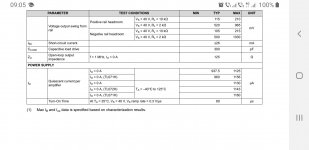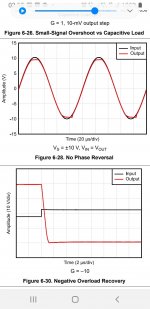Some of you might find it interesting:
https://eu.mouser.com/ProductDetail/Texas-Instruments/TL081HIDR?qs=pBJMDPsKWf2IEA%2Bv86wIaw==
https://eu.mouser.com/ProductDetail/Texas-Instruments/TL081HIDR?qs=pBJMDPsKWf2IEA%2Bv86wIaw==
TL series are wonderful, but I actually prefeer CMOS TLC series, faster and lower waste of energy mainly in battery operated rigs.
"outstanding value for cost-sensitive applications"
Reading between lines, the hiss is not as low as other cheap parts, and the specs imply a good dose of 1/f hiss.
Until I need a LOT more opamps, this does not call out to me.
Reading between lines, the hiss is not as low as other cheap parts, and the specs imply a good dose of 1/f hiss.
Until I need a LOT more opamps, this does not call out to me.
At first i thought it is something like TL072H but no. Overall an excellent opamp which keeps everything of original tl0xx series but with some nice improvements. Power consumption is also very low.
One thing the "H" suffix guarantees is: High Voltage. (Vcc - Vee) = 42 volts maximum. It's only 36 volts without the "H" suffix.
"integrated EMI and RF filters" are nice features that other opamps sometimes lack. Otherwise nothing really special except ultra low power consumption and not a threat to OPA1641/42/44 in audio applications it seems.
Probably the most recent/revised workhorse low cost opamp for a broad range of industrial applications.
Probably the most recent/revised workhorse low cost opamp for a broad range of industrial applications.
Last edited:
But unspecified? Not even hinted on schematic or packaging?"integrated EMI and RF filters" are nice features
And the output max still goes to zero at 100 Ohms load. Fig 6-44.
This is good to know: Device Functional Modes These devices are powered on when the supply is connected.
And the output max still goes to zero at 100 Ohms load. Fig 6-44.
Pretty surprising, since the short circuit {zero ohms!} output current is 26 mA. I'd expect that with 100 ohm load they'd get something around (0.026 * 100) = 2.6 volts or thereabouts.
Tl071h as well:
https://eu.mouser.com/ProductDetail/Texas-Instruments/TL071HIDR?qs=pBJMDPsKWf3B%2B9HtwS3vng==
https://eu.mouser.com/c/semiconduct...rs-op-amps/?m=Texas Instruments&series=TL071H
All parameters improved in all tl071 variations.They moved on with the technology.0.5dollars ...what can you ask more ?
https://eu.mouser.com/ProductDetail/Texas-Instruments/TL071HIDR?qs=pBJMDPsKWf3B%2B9HtwS3vng==
https://eu.mouser.com/c/semiconduct...rs-op-amps/?m=Texas Instruments&series=TL071H
All parameters improved in all tl071 variations.They moved on with the technology.0.5dollars ...what can you ask more ?
Last edited:
I'm sure i misread something about tl071h or didn't understand properly. What is input noise 'density' actually?
I won't as I made my choices already. No need to try another one only because it costs nothing. Price is a low key parameter when one is after quality.
20v/us is more than enough for audio,+-2.25v.... +-20v supply says it's not working only for battery operated devices, 940uA quiescent current keeps your battery alive ...I'm not gonna post all the datasheet of tl071h-tl081h here just because....TL series are wonderful, but I actually prefeer CMOS TLC series, faster and lower waste of energy mainly in battery operated rigs.
It is purely a choice if someone wants to have some 20 bucks op amps to sell in 2030 for a discount in the swap meet section ...
Attachments
Some junior draftsperson made that graph decades ago, and none of TI's editors since has fixed it.Pretty surprising, since
It is of course a confusion between LIN and LOG.
Do these also suffer from the inverting output / rail clamp when operating near rail Voltage like the elder ones ?
The old TI TL084 data sheet specified a common mode input range that you had to stay 4 volts away from both the rails.Do these also suffer from the inverting output / rail clamp when operating near rail Voltage like the elder ones ?
This is a lot of voltage and many designer got caught on this when using low voltage rails like +5V/-5V.
The new TL084H data sheet shows the common mode input range extends to the positive rail and down to only 1.5 volts above the negative rail.
A very big improvement.
Unfortunately TI has stated they will NOT release undated spice models for the "H" version making simulation of any of the "H" advantages not currently possible.
Pity, I stopped designing without spice in the 1980s.
- Home
- Design & Build
- Parts
- TL081H

